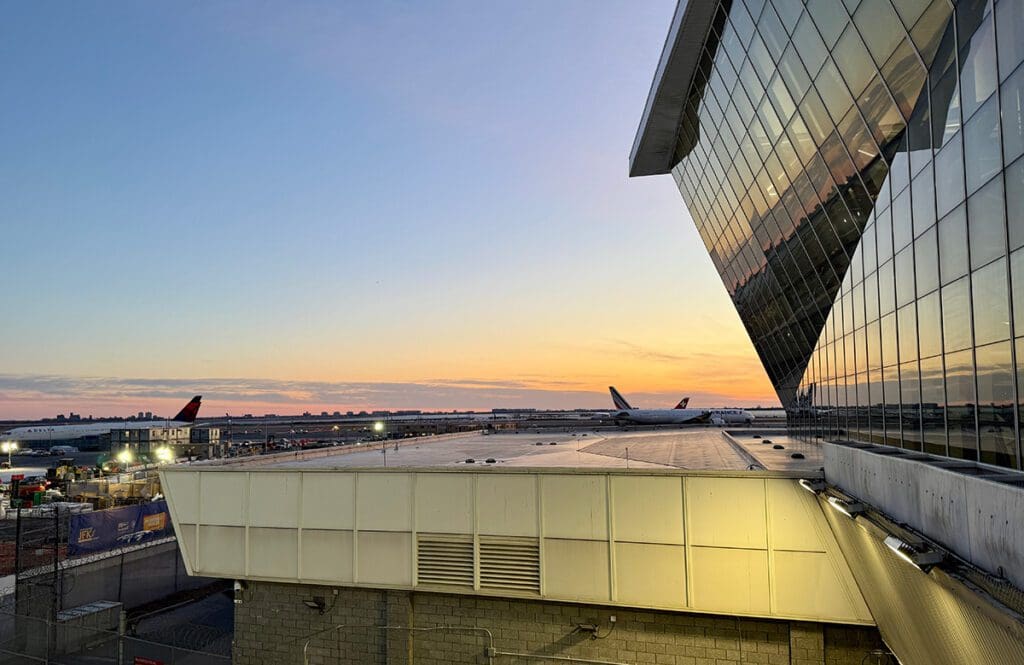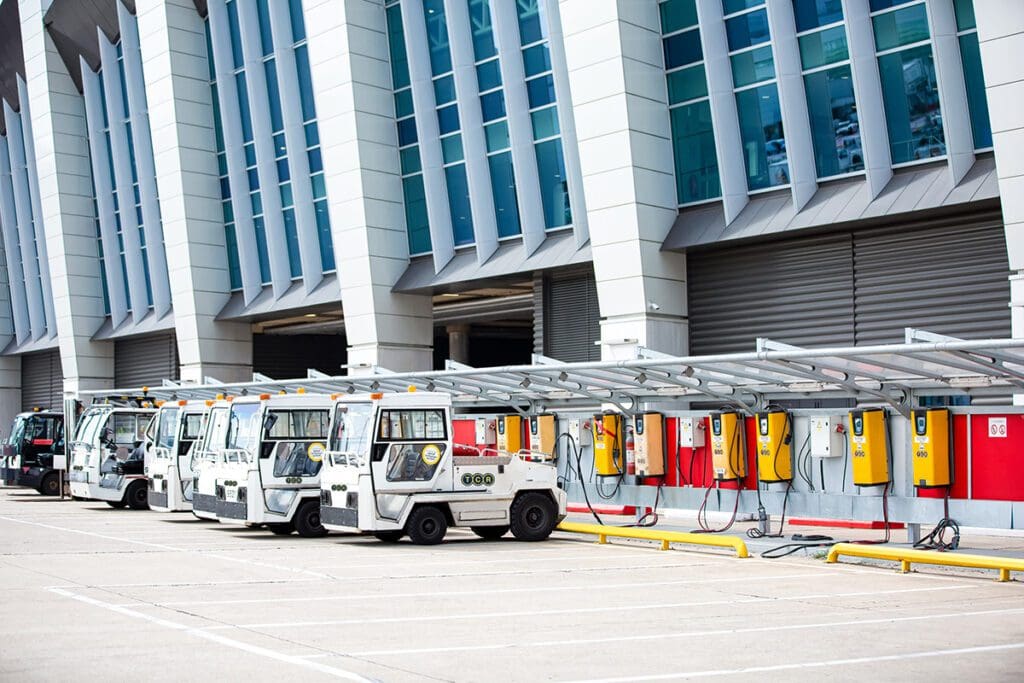

John F. Kennedy International Airport, the busiest airport for international traffic in North America, always seems to be reinventing itself. It opened in 1948 as New York International Airport, although it was typically referred to then as Idlewild. The airport was intended as the world’s largest and most efficient, with “no confusion and no congestion.”
As airport traffic grew, so did the need for larger and improved facilities. In 1954, architect Wallace Harrison designed a plan that gave major airlines their own terminals. The result was called Terminal City: five airlines had their individual terminals, three airlines shared a sixth terminal, and foreign airlines used the international arrivals terminal.
Since then, there have been multiple changes and reconfigurations. Now JFK is undergoing a $19-billion redevelopment project that, among several new terminals, includes the 2.4-million square-foot, 23-gate terminal dubbed the New Terminal One, which will be the largest at JFK—more than twice the size of the current Terminal 1, which opened in 1998.
The New Terminal One will have what its creators have said is the largest solar array at any US airport, which will power a fleet of electric vehicles used at the terminal both landside and airside. Construction of the massive array, consisting of more than 13,000 solar panels on the terminal’s roof, began in 2024.
As Port Authority of New York and New Jersey Chairman Kevin O’Toole said in announcing plans for the solar array, “Visitors from around the world will be energized from the moment they enter the New Terminal One at JFK.”




Photos by Jonathan Spira
It won’t only be the passengers who are energized. The New Terminal One’s solar array will support approximately 50% of the terminal’s energy requirements—an amount of energy that could power more than 3,500 average US homes. It will also be a blended system so that, at any point, the electric devices that keep things moving at a busy aerodrome will be running on 50% clean energy.
The 6.63 megawatts (MW) of solar energy will be part of a 12 MW microgrid. Located in four clusters of electrical generation infrastructure strategically placed around the new terminal to create a single smart, resilient energy system, this microgrid will also include 3.84 MW of fuel cells and 1.5 MW/3.34 MWh of battery energy storage to balance electrical demand and improve power quality. The system can operate independently from or while connected to the main power grid.
Benefits of electric ground support vehicles
The microgrid will supply the power to charge the many types of electric vehicles unique to airports.
Airports employ a vast array of vehicles large and small in their operations. Some operate airside (after security), and some landside, but their mission is critical to people (and baggage) moving. There are many operations that take place behind the scenes (which passengers rarely see), including maintenance, baggage handling and aircraft movement.
Many airport vehicles are quite visible to passengers, including baggage carts, baggage tugs, pushback vehicles, passenger shuttles and conveyor belt loaders. What passengers don’t typically see include the vehicles transporting luggage to storage operations in warehouses, those used by cleaning services, refrigerated vans for transporting food and meal trays, and vehicles that handle recycling and waste management.


As the move from diesel- or LP-powered vehicles to electric vehicles takes place at airports, it’s important to keep in mind that ICE-powered vehicles convert 20% to 30% of their fuel into propulsion, while EVs convert 80% to 90%.
Case study: Electric buses replace diesel bus fleet at JFK
The Port Authority took a giant leap into electrification four years ago when it replaced numerous ICE buses that bring passengers to the terminal with the driverless light-rail JFK AirTrain, which uses electric power. Even after the launch of the JFK AirTrain, the Port Authority still had a number of diesel coach buses.
After several years of planning, the Port Authority replaced its inter-terminal diesel-powered bus fleet in 2019 not only at JFK but also at LaGuardia and Newark Liberty airports, with 36 battery-operated Proterra Catalyst E2 Electric shuttle buses.
By taking the ICE-powered buses—which had consumed about 240,000 gallons of diesel fuel each year—out of service at JFK, the agency said it decreased its greenhouse gas emissions by approximately 40,000 tons per annum. Also, the 40-foot buses eliminated the emissions of approximately 2,000 pounds (907 kg) of nitrous oxide and 150 pounds of particulate matter annually that would otherwise have spewed into local residential neighborhoods in the borough of Queens in New York City, where the aerodrome is located.
Each bus can travel approximately 230 miles on a charge, and it takes four hours to fully recharge the bus.
Case study: Early electric tugs designed specifically for GM
In 2006, GM came to Eagle Tugs with a project to standardize its tow tractor (tugger) fleet across all its plants worldwide. Eagle designed the RTT series A/C electric line of tow tractors with extensive input from GM operators, as well as safety and manufacturing engineers.
The RTTs offer opportunity charging that allows the tuggers to handle three shifts of operation without having to replace batteries, they are ergonomically correct (being the only tuggers to offer operators stand-up and sit-down operation) and they deliver a 1,000-hour preventative maintenance schedule versus the 200-hour preventative maintenance schedule of other tow tractors.
In 2009, Eagle brought its expertise in designing and manufacturing A/C electric tow tractors to the aviation market.
“With Eagle Electric Tow Tractors, you can tow and push anything from people trams to rocket launch platforms efficiently, reliably and safely,” the company said.
Electrification at the New Terminal One
Airports operate 24/7, and they are tough environments for equipment that remains outdoors in rain, snow, sub-zero temperatures and other inclement conditions. Accordingly, the less likely it is that a pushback/tow tractor will fail to start or perform, the better it is for all concerned, from passengers to rampers to pilots to air-traffic controllers. EVs, given their fewer moving parts and minimal maintenance compared to the alternatives, are therefore ideal for airport environments.
Airside operations have depended on internal combustion-powered vehicles for decades, although that is slowly changing. On the tarmac, the use of EVs such as tugs, baggage carts and passenger shuttles is gaining acceptance, and JFK’s New Terminal One—in order to meet its sustainability goals—is aiming to replace all such vehicles in use at the current Terminal 1 at a rapid pace.
Tim Castaldy, a Senior Electrical Designer at Nevada-based PK Electrical, examined the impact of EVs on airport ground transportation in a recent blog post, and took the time to provide real-life illustrations of the following issues that were put forth to him in an interview covering his work with Denver International Airport, an electrification client.
Health issues – Ramp workers and others who work airside are constantly exposed to toxic emissions, and many face health issues as a result, Castaldy said.
Cost-benefit ratio – While electric airside vehicles are noticeably more expensive than conventional-powered ones, over the lifetime of a vehicle, the cost savings accrued from lower maintenance costs as well as the lower cost of electric power versus diesel or gasoline were verifiable.
Noise pollution – EVs are much quieter than their non-electric counterparts and lessen the impact of noise pollution on the health of airport workers. The move to telecommuting in the first years of the pandemic led to the disclosure of a number of health issues from non-airport workers with residences near airports, so it is not hard to imagine the health impact to airport workers themselves.
Efficiency – Since EVs have significantly more low-end torque, they are ideal for towing aircraft and more efficiently transferring heavy loads, Castaldy underscored.
Cold weather operation – Electric airside vehicles have been found to be more reliable in cold weather than their counterparts, Castaldy said. “Cold weather reliability (is a strong justification for) EV tugs,” he said. “The ICE tugs can have difficulty starting in cold weather, which is not the case with the EVs.”
How the electrons will get to the New Terminal One’s EVs
The contractor for the microgrid, AlphaStruxure, is financing the project through an Energy as a Service contract, essentially a pay-for-performance, off-balance-sheet financing solution, which will allow the Port Authority to implement energy efficiency projects with zero upfront capital expenditure. Over the life of the contract, AlphaStruxure will be responsible not only for the construction, but also the operation and maintenance of the microgrid.
Will the ground services EVs be running solely on solar energy at certain junctures? The answer is a resounding, “it’s possible but it depends,” according to Michelle Charello, VP of Marketing at AlphaStruxure. “At this stage, AlphaStruxure and the New Terminal One cannot pinpoint the exact contribution from the microgrid due to the fact that the microgrid will provide overall electricity to the terminal and vehicles, meeting demand for loads up to its production capacity. Since we cannot direct electrons to specific loads, the microgrid will supply whatever demand exists, limited to its available output.”
Nonetheless, given the law of variable constants and proportions, it is likely that on rare—or perhaps not so rare—occasions, some EVs will receive 100% solar energy.









